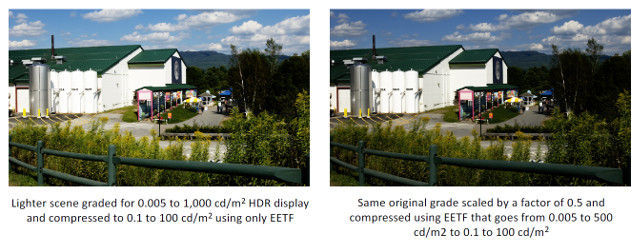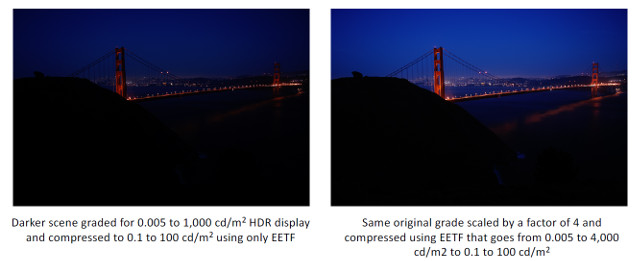Several papers at the SMPTE conference were aimed at colorists working on the grading of HDR and WCG content. This is still a new area and most colorists have not yet tried to grade HDR/WCG content so there is a need for those more experienced to provide some hints, tips and updates to tools available for this.
Today, HDR mastering displays are either OLED or LCD with a range of peak luminance from 1000 to 4000 cd/m² and support for the DCI-P3 color gamut. End-user HDR displays, primarily TVs, exists with luminance levels from 300 to nearly 1800 cd/m² and color gamuts ranging from BT.709 to DCI-P3 and beyond with quantum dot or laser technology.Jack Holm of Tarkus Imaging presented a paper in which he said that creating masters for all these variations, plus proprietary formats like Dolby Vision, is just not possible.
He asked some of the key questions facing colorists, namely:
- How are code values outside the mastering display capabilities displayed?
- Should content be limited by the mastering display capabilities?
- What happens when the actual display to be used is different from the mastering display?
- What happens when the viewing environment is significantly different from the mastering environment?
At the end user, the first thing is to verify what “exactly is the intended appearance, on what display and in what viewing environment.” In other words, what is the gamma curve (HLG or PQ), what is the color gamut and is there any metadata (static or dynamic)? If there is no metadata, the TV should assume the content was mastered at 0.005 to 1000 cd/m² and with the P3 color gamut.
Since end user TVs have a wide range of luminance levels and color gamut capabilities, some adaptation of the delivered master is likely to occur. In general, four things will occur at the TV:
- Tone mapping of the source to target luminance levels
- Color gamut mapping for the source to target gamut
- Adaptation for the viewing environment
- Dealing with encoding differences
Holm then introduced the concept of a soft master and a hard master. He said a hard master encodes exactly what creatives saw on their mastering display and there are no image values outside of the mastering display’s color volume. The advantage of the hard master is that the colorists has decided how to remap out of gamut color and tone map for out-of-range high luminance level.
With a soft master, there are delivered image values that lie outside of the mastering display’s color volume and dynamic range. This is accomplished in grading by turning off tone mapping and color gamut mapping functions in the monitor. That means the TV will decide how to map out-of-gamut color and out-of-range luminance values to the capabilities of the TV.
Holm then provided one of the best examples of problems that can occur with out-of-gamut color mapping. In the figure below, which focuses on remapping color from the HDR master to an SDR display, the original content has colors at the edges of the BT.2020 gamut (blue dots). The mastering display hard clips these colors to BT.709 (top row of colors and green dots), but an end user display may use a hue preserving gamut mapping technique and see completely different colors (bottom row of colors and red dots). This can happen when the colorist creates a soft master.
Holm makes the same point with soft and hard tone mapping. For example, soft tone mapping means displays compress the entire PQ luminance range to whatever the actual display range is. The result of such compression is that the encoded values are not displayed as specified. Hard tone mapping clips out-of-range luminance values or applies a tone mapping curve (not necessarily known to the end user display).
Another issue to consider with the mastering display is dynamic dimming. If such a display is used for grading, the colorist may lower the luminance of a bright window in a scene for a better aesthetic. If the scene is displayed on a TV without dynamic dimming, the window will be brighter than the colorist intended.
As a result, “soft” masters are problematic, but not always catastrophic. Holm said that, “In many cases they will not cause problems, but it can be difficult to predict when they will cause problems, and the problems when they occur, can be objectionable. Likewise, mastering displays employing display adaptation (such as dynamic range/color gamut compression/expansion) should be avoided for mastering, because they can result in the encoded values not representing the colorimetry seen by the creative talents.”
Dynamic range may also need to be expanded or compressed depending upon the capabilities of the display and the viewing environment. There are three basic ways to do dynamic range compression. One is to adjust the scene-specific mid tone levels so they are closer to SDR levels and the other is to do highlight and shadow compression using an EETF. The third way is a combination of the above two methods.
What is an EETF? It stands for Electrical-Electrical Transfer Function and is a curve that maps incoming luminance ranges to lower luminance ranges, i.e., a tone mapping curve. BT.2390 provides details for performing tone mapping from the full PQ range to a range of 0.01 to 1000 cd/m², but not an arbitrary range. As a result, Holm offered his own formula for doing so and showed example of compressing from HDR to SDR. His method first scales the luminance by a factor before applying the EETF, which results in better preservation of the highlights and shadows (photo).


The mastering environment has also been standardized in BT.2100. This is done in a dim room, but HDR content is not always watched in a dim room – and content creators cannot control this. For brighter rooms, images can look darker and details in the shadows can be lost. As a result, display luminance needs to be increased, naturally resulting in a more colorful image, with tone mapping optimization. Holm recommends that displays that are capable of displaying higher than 1000 cd/m² use this extra headroom to “maintain the 1000 cd/m² HDR master appearance.” However, there is no standardized way to do this yet. -CC

